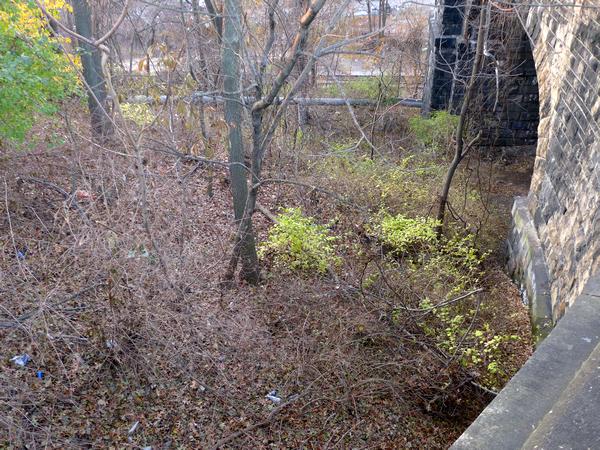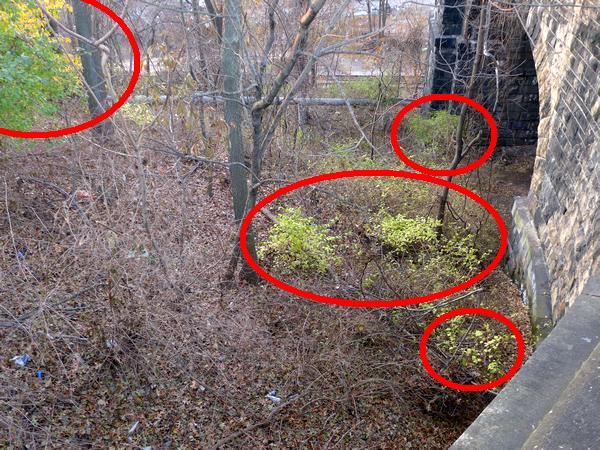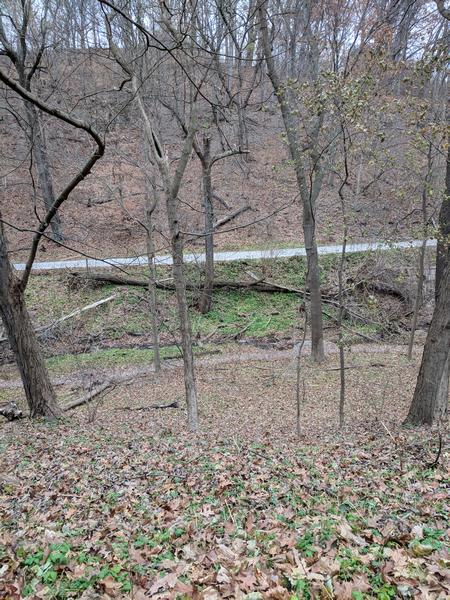
Late fall is the perfect time of year to look for alien plants in Pennsylvania. Natives are brown or leafless but alien species are still cuing on the seasons back home.
How do you find aliens? Notice patches of green in the brown landscape. Here are three photos to give you some practice.
Aliens in the top photo are circled below.

See aliens while you’re driving …


See aliens on the ground …


There’s so much goutweed and garlic mustard in this last photo that it would be filled with red circles if I labeled all of it. 🙁
(photos by Kate St. John)
What can be done about it?
In managed landscapes people pull out the invasives and, yes, there are volunteers who do this in Schenley Park. Unfortunately goutweed is so pervasive that it’s only thing growing on the hillsides & can’t be removed without causing bare earth, massive erosion and a new invasion. In these cases, and in unmanaged landscapes, we ultimately just give up.
One of the characteristics of invasive species is they are able to thrive and grow when our native species can’t/don’t. So, if a foreign species is not able to start its growing season earlier, or make it last longer than the native species, it might not take hold well enough to become invasive. They also tend to have a greater ability to reproduce and/or disperse. Not all foreign/exotic/alien species have these abilities, but the ones that do ‘take off’ and become invasive. The absence of natural predators is another factor in the ability of an invasive species to become dominant. Many invasive species are not dominant species in their natural environment because predators or competitors are limiting.
We can try to kill off the invasive species, and plant or protect the native species, but we are fighting evolution. Limiting the number of foreign species that enter an area is another tactic, but that has no effect on what is already here. Like Kate says, in small areas where teams of volunteers (or homeowners) are willing to put in the work, it can help. Protecting the few remaining natural areas and preventing foreign species from entering is important too. Encourage your neighbors to tend to native species and limit exotic species, learn about what is native and what horticultural varieties have become invasive, involve the local schools in taking up this cause, and focus on the places and species where your efforts have the best chance of succeeding (which is why, as Kate says, in some instances we just give up).
It’s not as simple as “native=good”, “introduced=bad”. The Chinese Chestnut trees that I planted in my yard are favorites of the squirrels and deer. On the other hand, the NATIVE poison ivy that has taken over in my woods could go grow somewhere else in my opinion.
What about trees and shrubs whose leaves are brown and leafless but still clinging determinedly to their branches? I’m thinking, specifically, about Chinese Chestnut (mine, my fault, I admit it) but more about my neighbor’s pin oaks. Are pin oaks native or introduced? Anyway, these hold their dead leaves and drop them constantly from fall to late winter. The trees are planted along the roadside upwind from my yard, so I get the benefit of all those leaves. Gather them up, the next day there will be more.
Lifeless, not “leafless”.
Want to learn a new word? This will answer your question, Peggy. A new word for me. I like his blog almost as much as Kate’s, 🙂 http://capitalnaturalist.blogspot.com/2015/12/marecensce-and-legend-of-evergreens.html